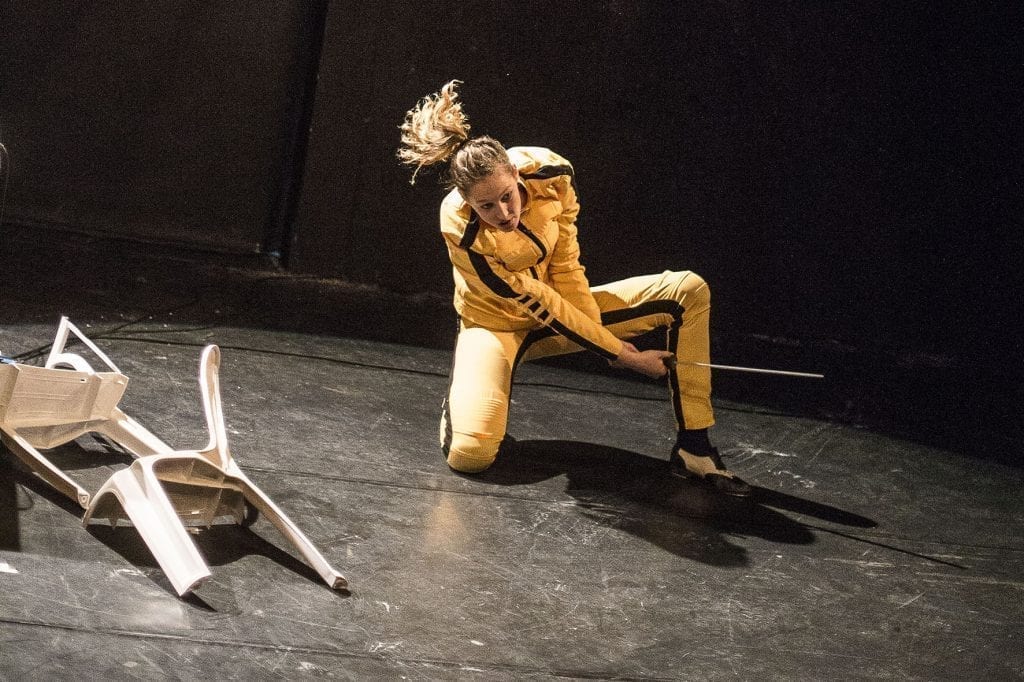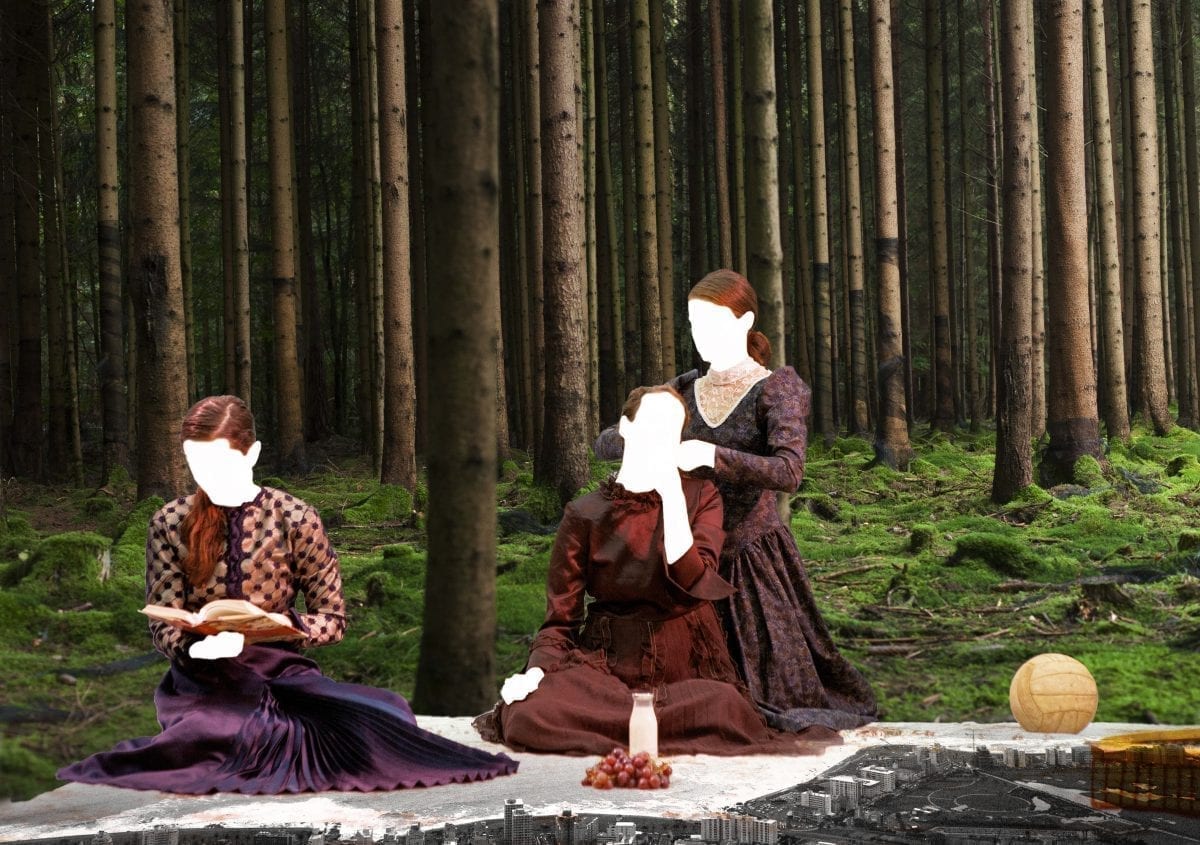We are having a cultural moment, yes, about the pervasiveness of sexual assault, sparked by events in the US (Harvey Weinstein, et al) — but with repercussions felt around the world. This includes Israel, which I visited for the International Exposure of Israeli Theater, sponsored by the Hanoch Levin Institute of Israeli Drama.
Here in Tel Aviv artists from around the country explored the way that the stage can be used as a tool of inquiry and transformation. And it’s a good thing, too, as one still hears, in Israel – I heard last week – middle aged and older people saying that a great deal of fuss is being made over a stolen kiss or a tone-deaf gallantry. Women are crying victim, one still hears. In the US many might also feel this way but are less inclined to say so. Which makes it all the more imperative to discover how the power of art can be used to bring greater awareness.
Four excerpted plays were included in the presentation called “Reclaiming the Space: Coping with Sexual Assault On Stage.” All asked, how can the ceremonies of drama be used to illuminate implicit social hierarchies? And, most especially, how can we make such theater electric and exploratory, and not tediously didactic? Each performance in the presentation put the audience through an experience that reached past the merely cognitive. The first examined the use that Freud’s revered inspiration and teacher, the French neurologist Jean-Martin Charcot, made of the hysterical women he paraded before an inquisitive and titillated Victorian male audience. A second dramatized the true story of a sixteen-year-old girl who was asked to re-enact before a Jerusalem courtroom in 2008 the various positions in which she had been raped by four boys (in an odd parallel to the exploitative displays of Charcot). A third featured a woman refusing the disempowered identity of assault victim, and who instead zestfully portrayed a ninja warrior, among other personae. And the last showcased an actor investigating the source of his inhibitions onstage who re-discovered that he’d been sexually assaulted by a trusted teacher, an experience so shaming and overwhelming it was for a decade utterly repressed. In all of the presented works the live audience was put to good use, sometimes serving as confessor, sometimes voyeur, and sometimes soulful and stricken witness.
In Adili Liberman’s “Living Pathological Museum,” the creator and actress takes on the role of Dr. Charcot himself, mightily striding about, his manner aloof, while a female actor portrays one of the hysteria victims triggered to go quite publically through her repertoire of symptoms. She gesticulates, contorts, curls her hands into useless claws so fingers touch wrists, arches her back, pants and moans. At last she is restored to a placid state, although having apparently reached an erotic climax first. The master’s cool analytic style contrasts dramatically with the grotesque postures of the suffering mental patient (who is also a victim of hypnotic suggestion). Questions of health and illness, of suffering and toxic detachment, and of expert and apparentlydefective humanity are raised – or rather, experienced. And one experiences, as well, a lingering worry about the very origins of psychoanalysis and its own erratic relationship with both compassion and with women’s actual mental health. As an audience member, one feels horror and pity at the contortions the isolated woman is induced to go through, and one feels, as well, that such pathologizing still continues, in a different key.
Demonstrate is also derived from historical documents, although of much more recent vintage. None of the words we hear or actions we witness are invented for this production. And yet we think, “How can this be true?” That, however, isn’t the main question the artist is asking. Hers is more interesting. It is: How can decent people be brought to do something cruel?
The actual trial was held in 2008 at the county courthouse in Jerusalem. It involved a sixteen year old girl raped by four boys. She is treated with blatant contempt by the defense attorney, a lawyer with a big voice who accuses the sexual assault center the girl went to of “putting words in her mouth,” and who actually asks the plaintiff if she was “wet” during the rape. Interestingly, the part of the rape victim is here played by a young man, and the judges and lawyers are portrayed by women. When I heard of this gender switching, it seemed gimmicky to me but, in fact, in performance it absolutely is not.
“Doing it in the original genders makes it almost pornographic,” Silberg, the originator of the piece, explained. “And you almost just want to cover your face and hide. In a weird way, the gender switching helps create empathy for the judges” – a conclusion I felt accurate.
“I wasn’t interested in being didactic, in ‘poor little girl’,” said Silberg. Rather, she wanted to investigate, “How did it happen that they [the attorneys and judge] would do this? — the way they ignore the girl’s trauma.” She adds: “This way of presenting the material allows thinking and not only being horrified.”
Demonstrate – chimes chillingly with the role of bureaucracy in the holocaust, with what Arendt called the banality of evil, and with psychology experiments in which ordinary people voluntarily submit to an authority figure’s inhumane commands. The artist’s use of distancing techniques allow for a fascinating and heart-rending emotional and intellectual experience, but even so one is inclined to simply think, of the attorneys: What beasts.
In “Sweetie, You Aint Guilty,” Gony Paz also comes up with a strong solution to the problem of portraying traumatic material on stage, and to the problem, too, of taking on the role of victim. “People try to push away this notion of a victim who continues her life and is okay now and she looks good, and has a relationship,” says Paz. “Because people don’t behave like victims, it seems toothers it didn’t happen.”

Still, Paz didn’t want to be pitied. Her own performance allows her to mentally transform into Kurt Cobain and lip synch (most brilliantly) to his potent “Smells Like Teen Spirit”, then later to become a tapdancing ninja warrior – strategies whose almost desperate force allows us to intuit the wounded spirit beneath.
Amit Ghoul’s “My Life, the Musical” was the most technically conventional of all the work presented, being a one-man show based on the performer’s own history. It was also the most impactful. It demonstrated how a sexual assault can have subtle repercussions over the course of decades, something many of us only dimly comprehend. The work has its origins in Ghoul’s own life: His professional work was hampered. He was constricted on-stage. He couldn’t really take suggestions from theater directors — “so I wasn’t such a good actor because something was amiss.” What was holding him back? During Vipassana meditation, the answer came. He’d been molested ten years earlier by someone who, he revealed in discussion after the performance, is very well-known in the Israeli theater world. Recovering this memory, Ghoul initially became quite depressed. And yet it was the first step toward real freedom.
To Ghoul, his play involves the search for a boy’s inner voice. “You can lose your voice in various ways. Life can rape you in various ways,” he said. “My ability to trust other people is better now. I created this show to save myself.” And one feels that it saves the audience too in a way. Ghoul’s vulnerability allows us to perceive the profound effects of having one’s body violated. The experience of being taken over infiltrates a person’s soul, one comes to understand. The viewer witnesses, as well, the humiliation that men experience from being sexually exploited, a shame compounded by the fact that our culture says they are supposed to be invulnerable. The performance left me more deeply appreciative of how an apparently common crime (I’m thinking of the Me-Too campaign) impacts those people it victimizes.
Sexual assault usually occurs without witnesses, hence the disbelief in victims’ testimony, the shame, and the corrosive long-term consequences to the spirit. These artists let us be witnesses. It’s tough and liberating – for them, and for us –and essential.

